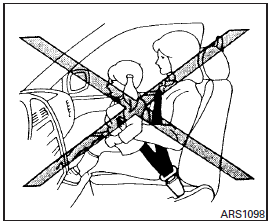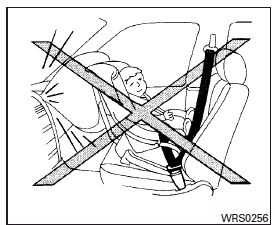Precautions on child restraints



WARNING
● Failure to follow the warnings and instructions for proper use and installation of child restraints could result in serious injury or death of a child or other passengers in a sudden stop or collision:
– The child restraint must be used and installed properly. Always follow all of the child restraint manufacturer’s instructions for installation and use.
– Infants and children should never be held on anyone’s lap. Even the strongest adult cannot resist the forces of a collision.
– Do not put a seat belt around both a child and another passenger.
– INFINITI recommends that all child restraints be installed in the rear seat. Studies show that children are safer when properly restrained in the rear seat than in the front seat. If you must install a forward-facing child restraint in the front seat, see “Forward-facing child restraint installation using the seat belts” later in this section.
– Even with the INFINITI Advanced Air Bag System, never install a rearfacing child restraint in the front seat. An inflating air bag could seriously injure or kill a child. A rearfacing child restraint must only be used in the rear seat.
– Be sure to purchase a child restraint that will fit the child and vehicle.
Some child restraints may not fit properly in your vehicle.
– Child restraint anchor points are designed to withstand loads from child restraints that are properly fitted.
– Never use the anchor points for adult seat belts or harnesses.
– A child restraint with a top tether strap should not be used in the front passenger seat.
– Keep seatbacks as upright as possible after fitting the child restraint.
– Infants and children should always be placed in an appropriate child restraint while in the vehicle.
● When the child restraint is not in use, keep it secured with the LATCH system or a seat belt. In a sudden stop or collision, loose objects can injure occupants or damage the vehicle.
CAUTION
A child restraint in a closed vehicle can become very hot. Check the seating surface and buckles before placing a child in the child restraint.
This vehicle is equipped with a universal child restraint anchor system, referred to as the LATCH (Lower Anchors and Tethers for CHildren) system.
Some child restraints include rigid or webbing-mounted attachments that can be connected to these anchors. For details, see “LATCH (Lower Anchors and Tethers for CHildren) system” later in this section.
If you do not have a LATCH compatible child restraint, the vehicle seat belts can be used.
Several manufacturers offer child restraints for infants and children of various sizes. When selecting any child restraint, keep the following points in mind:
● Choose only a restraint with a label certifying that it complies with Federal Motor Vehicle Safety Standard 213 or Canadian Motor Vehicle Safety Standard 213.
● Check the child restraint in your vehicle to be sure it is compatible with the vehicle’s seat and seat belt system.
● If the child restraint is compatible with your vehicle, place your child in the child restraint and check the various adjustments to be sure the child restraint is compatible with your child. Choose a child restraint that is designed for your child’s height and weight.
Always follow all recommended procedures.
All U.S. states and Canadian provinces or territories require that infants and small children be restrained in an approved child restraint at all times while the vehicle is being operated. Canadian law requires the top tether strap on forward-facing child restraints be secured to the designated anchor point on the vehicle.
See also:
LATCH lower anchor
WARNING
Failure to follow the warnings and instructions for proper use and installation of child restraints could result in serious injury or death of a child or other passengers in a sudden stop o ...
New for 2012
Always a polarizing design, the FX has changed incrementally, again, for
2012, with a new grille that one of our editors thinks is an improvement. To me,
it's a step back. (For a while, Infiniti g ...
Headrest (2nd row center seat) (if so equipped)
Removal and attachment
To remove the headrest, push and hold the
lock knob 1 and pull the headrest up.
If the headrest is removed, store it in a
secure place. Reinstall the headrest when
th ...
